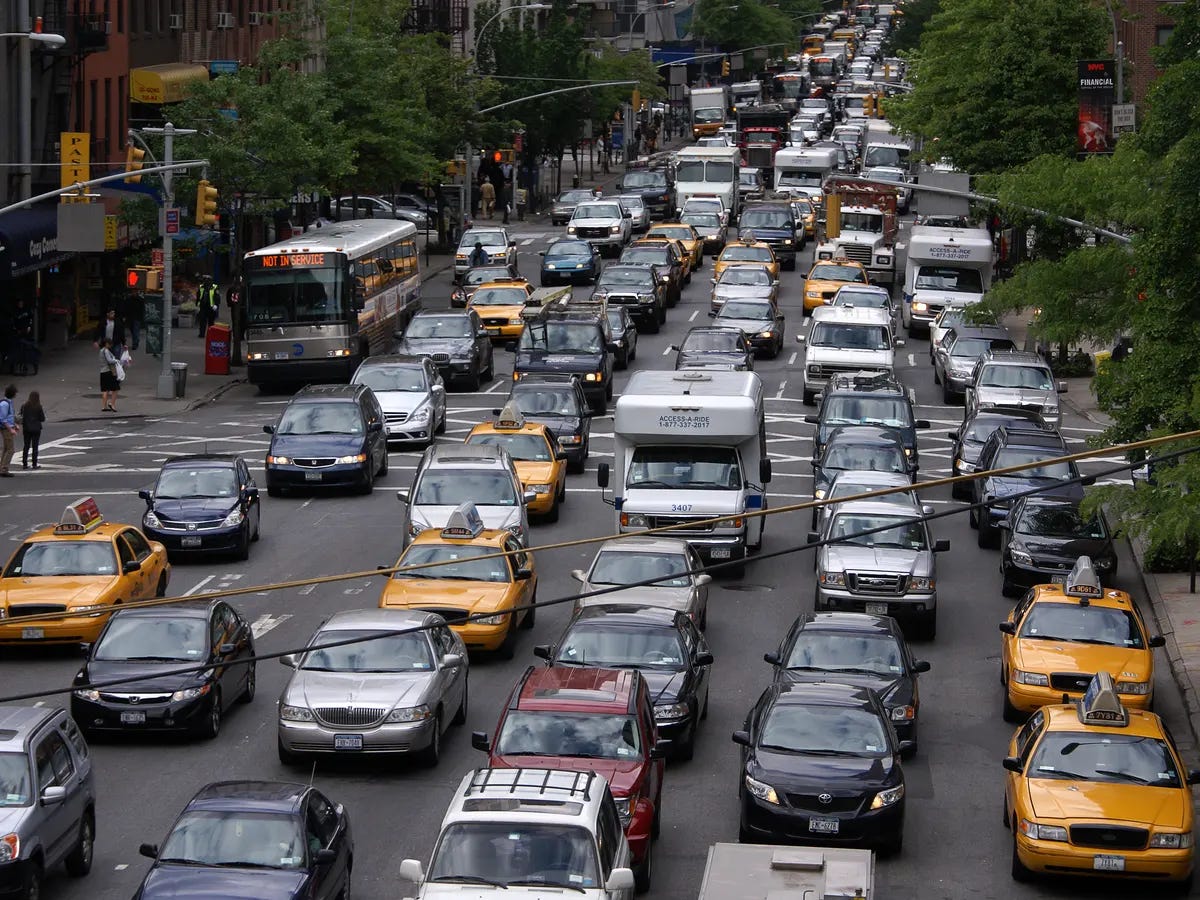Punitive Solutions Preferred, Part 2
New York City Councilman Joe Borelli threw shade at a plan to introduce congestion pricing as a means of alleviating traffic congestion in the heart of Manhattan. He pointed out the failure of the policy to achieve its goal in London, citing studies that a - traffic is still bad, and b - that people adapted by congesting the roads just outside the pay area. So much so that London's mandarins have tried to manage it through other restrictive measures - which aren't working out so great either. The London program's getting a massive makeover, because it is Not. Working. As. Intended.
Weekday traffic in Manhattan is bad. Bad enough to warrant active response from the people tasked with managing the city.
This isn't news. Managing the scarce resource that is public thoroughfares in a water-locked city is a proper duty of elected officials. It's also something that New York mayors and their deputized managers have been doing ever since there was a city. Manhattan's grid street pattern is the result of an 1811 plan, and as any city regular will likely tell you, is much easier to navigate than the organic mishmash of roads below 14th Street.
Alas, "easier" has fallen out of the vocabulary of the city's Best-and-Brightest the past couple decades, starting with Mike Bloomberg's tenure as Mayor, which began in 2002. His Department of Transportation appointee, Janette Sadik-Khan, sought to make things worse for drivers coming into "the city," by eliminating lanes of traffic, installing bicycle thoroughfares, converting major intersections into pedestrian plazas, and finding other ways to tell drivers "you're not wanted." Bloomberg and Sadik-Khan hated cars in their beloved Manhattan, and sought to implement congestion pricing more than a decade ago.
New York's always been a "tale of two cities," with the outer boroughs deemed "lesser, but necessary" feeders for Manhattan and its residents (many of whom are transplants and imports who, amusingly, look down their noses at the B&T (that's 'bridge and tunnel') folks the moment they move into some shoebox of a Manhattan apartment. Those feeders are supposed to do their thing without inconveniencing the residents, and so the moves to make life miserable enough for drivers that they stay out or opt for public transportation are popular.
The roadway "reclamations" haven't proven enough of a hindrance, so here comes the other stick: charging drivers a fee for the privilege of driving anywhere in the lower half of Manhattan, excepting the perimeter roadways, during business hours.
On paper, it sounds like a reasonable remedy, even from a libertarian perspective: Pay for what you use, and since supply is low and demand high, a price signal that's significant can be justified.
However, this wouldn't be a market-driven price, but one set by politicians, who have priorities that do not include than facilitating the freest movement of people.
This is active behavioral control. It is negative reinforcement. It is a parent whacking a child's hand with a stick when the child reaches for a cookie. It is public management, not public service, and it is a symptom of an increasing shift in the notion of "service" from 'representative of the people' to 'overseer of the unwashed masses.' From steward to sheepdog.
That it adds Other People's Money to the coffers is, of course, its own enticement.
That it won't work "as intended" is a virtual certainty. Government efforts at behavior modification rarely do. From Prohibition to the War on Drugs to various sin taxes to blue laws to soda and other "fat" taxes to rent control laws to excessive zoning regulations, government efforts to modify 'market' behaviors overpromise, underproduce, and generate unintended negative consequences.
All this is routinely ignored, of course, because most politicians default to a "control them" mindset and a simplistic "if X is happening and is causing problems, we must ban X" solution path.
It would never occur to today's Best-and-Brightest to work on solutions that would let cars move more freely in high congestion zones. Or, if it does, they're apt to give them low priority. Two of the biggest plagues in driving in heavy street traffic - "block the box" gridlockers and jaywalking pedestrians - no longer get discussed. Ditto for putting engineers on improving traffic flow, and adjusting roadway layouts to move cars more easily.
Cars, among the greatest liberators of the masses in history, are out of favor among the "know better" elites. Electrics are OK, for now, because they feed the green delusion and enable a "let them eat cake" answer to citizens' complaints about gas prices. The real dream, however, is to get us all into trains and buses.
No matter that we don't want to.
Because we don't want to, it often seems.
Rather than figure out how to make our lives easier, the people who run society on our behalf continue to look for ways to make them more difficult. For our own good, they tell us. For their own satisfaction, they deny.
Editor's note: A follow-up (and very likely not the only one) to Punitive Solutions Preferred, originally published in 2019.
If you like this post, please share it far and wide. Scattering seeds is how we sow liberty.
If you like what I write, please subscribe (if you have already, thank you!), and please recommend the blog to your friends! While I share it as much as I can on social media, we all know those get filtered and you're not apt to see all shares.
If you *really* like The Roots of Liberty and want to help keep it rolling, please consider becoming a paying subscriber here at Substack, or at a lighter level as contributor to the blog via Patreon.
Thank you for your support!
Yours in liberty,
Peter.


